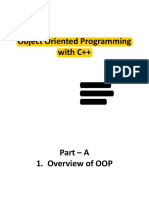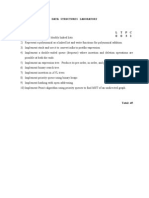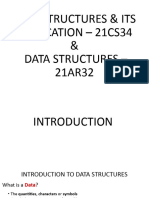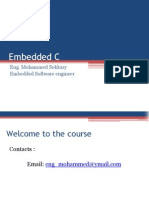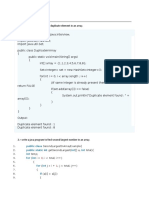C++ STL: CSCI 3110
C++ STL: CSCI 3110
Uploaded by
Suganya SelvarajCopyright:
Available Formats
C++ STL: CSCI 3110
C++ STL: CSCI 3110
Uploaded by
Suganya SelvarajOriginal Description:
Original Title
Copyright
Available Formats
Share this document
Did you find this document useful?
Is this content inappropriate?
Copyright:
Available Formats
C++ STL: CSCI 3110
C++ STL: CSCI 3110
Uploaded by
Suganya SelvarajCopyright:
Available Formats
CSCI 3110
C++ STL
STL Standard Template Library
Collections of useful classes for common data
structures
Ability to store objects of any type (template)
Study of containers
Containers form the basis for treatment of data
structures
Container class that stores a collection of data
STL consists of 10 container classes:
Sequence containers
Adapter containers
Associative containers
STL Containers
Sequence Container
Stores data by position in linear order:
First element, second element , etc:
Associate Container
Stores elements by key, such as name, social
security number or part number
Access an element by its key which may bear no
relationship to the location of the element in the
container
Adapter Container
Contains another container as its underlying
storage structure
STL Containers
Sequence Container
Vector
Deque
List
Adapter Containers
Stack
Queue
Priority queue
Associative Container
Set, multiset
Map, multimap
Vector Container
Generalized array that stores a collection of
elements of the same data type
Vector similar to an array
Vectors allow access to its elements by using an
index in the range from 0 to n-1 where n is the size
of the vector
Vector vs array
Vector has operations that allow the collection to
grow and contract dynamically at the rear of the
sequence
Vector Container
Example:
#include <vector>
.
.
.
vector<int> scores (100); //100 integer scores
vector<Passenger>passengerList(20); //list of 20
passengers
Vector Container
Allows direct access to the elements via an index
operator
Indices for the vector elements are in the range
from 0 to size() -1
Example:
#include <vector>
vector <int> v(20);
v[5]=15;
Vector Operations
See
http://cs.smu.ca/~porter/csc/ref/stl/cont_vector.html
For list of vector operations.
List Container
Stores elements by position
Each item in the list has both a value and a
memory address (pointer) that identifies the next
item in the sequence
To access a specific data value in the list, one
must start at the first position (front) and follow
the pointers from element to element until data
item is located.
List is not a direct access structure
Advantage: ability to add and remove items
efficiently at any position in the sequence
STL List
See
http://cs.smu.ca/~porter/csc/ref/stl/cont_list.html
for list of STL list operations.
Stack Container
Adapter Container
These containers restrict how elements enter and
leave a sequence
Stack
allows access at only one end of the sequence (top)
Adds objects to container by pushing the object
onto the stack
Removes objects from container by popping the
stack
LIFO ordering (last end, first out)
Queue Container
Queue
Allows access only at the front and rear of the
sequence
Items enter at the rear and exit from the front
Example: waiting line at a grocery store
FIFO ordering (first-in first-out )
push(add object to a queue)
pop (remove object from queue)
Priority Queue Container
Priority queue
Operations are similar to those of a stack or queue
Elements can enter the priority queue in any order
Once in the container, a delete operation removes
the largest (or smallest) value
Example: a filtering system that takes in elements
and then releases them in priority order 8
18 13
3 15
27
Set Container
Set
Collection of unique values, called keys or set
members
Contains operations that allow a programmer to:
determine whether an item is a member of the set
insert and delete items very efficiently
5 1 3
6 27 15
Buick
Ford
Jeep BMW
Set A Set B
Multi-Set Container
A multi-set is similar to a set, but the same value
can be in the set more than once
Multi-set container allows duplicates
Map Container
Implements a key-value relationship
Programmer can use a key to access
corresponding values
Example: key could be a part number such as
A24-57 that corresponds to a part: 8.75 price and
Martin manufacturer
A22-56
A23-57
A24-57
A24-57 8.75 Martin
A22-56 12.50 Calloway
A23-57 4.95 Mirage
Multi-map Container
Similar to a map container
Multi-map container allows duplicates
How to access Components -
Iterator
Iterator is an object that can access a collection
of like objects one object at a time.
An iterator can traverse the collection of objects.
Each container class in STL has a corresponding
iterator that functions appropriately for the
container
For example: an iterator in a vector class allows
random access
An iterator in a list class would not allow random
access (list requires sequential access)
Common Iterator Operations
* Return the item that the iterator currently
references
++ Move the iterator to the next item in the list
-- Move the iterator to the previous item in the
list
== Compare two iterators for equality
!= Compare two iterators for inequality
STL List Class
Constructors and assignment
list <T> v;
list<T> v(aList);
l=aList;
Access
l.front() ----returns 1
st
element in the list
l.back()----returns the last element in the list
STL List
Insert and Remove
l.push_front(value)
l.push_back(value)
Iterator Delaration
list<T>::iterator itr;
Iterator Options
itr = l.begin() set iterator to beginning of the
list
Itr = l.end() set iterator to after the end
of the list
Writing classes that work with the
STL
Classes that will be stored in STL containers
should explicitly define the following:
Default constructor
Copy constructor
Destructor
operator =
operator==
operator<
Not all of these are always necessary, but it
might be easier to define them than to figure out
which ones you actually need
Many STL programming errors can be traced to
omitting or improperly defining these methods
More on STL Lists
Go to: http://cs.smu.ca/~porter/csc/ref/stl/
Create a client file to read in 20 numbers
into a list and print the list in reverse order.
Component Description
Containers Containers are used to manage collections of objects
of a certain kind. There are several different types of
containers like deque, list, vector, map etc.
Algorithms Algorithms act on containers. They provide the means
by which you will perform initialization, sorting,
searching, and transforming of the contents of
containers.
Iterators Iterators are used to step through the elements of
collections of objects. These collections may be
containers or subsets of containers.
#include <iostream>
#include <vector>
using namespace std;
int main()
{ // create a vector to store int
vector<int> vec;
int i;
// display the original size of vec
cout << "vector size = " << vec.size() << endl;
// push 5 values into the vector
for(i = 0; i < 5; i++)
{
vec.push_back(i);
}
// display extended size of vec
cout << "extended vector size = " << vec.size() << endl;
// access 5 values from the vector
for(i = 0; i < 5; i++)
{
cout << "value of vec [" << i << "] = " << vec[i] << endl;
}
// use iterator to access the values
vector<int>::iterator v = vec.begin();
while( v != vec.end())
{
cout << "value of v = " << *v << endl; v++;
}
return 0;
}
vector size = 0
extended vector size = 5
value of vec [0] = 0
value of vec [1] = 1
value of vec [2] = 2
value of vec [3] = 3
value of vec [4] = 4
value of v = 0
value of v = 1
value of v = 2
value of v = 3
value of v = 4
The push_back( ) member function inserts value at the end of the vector, expanding
its size as needed.
The size( ) function displays the size of the vector.
The function begin( ) returns an iterator to the start of the vector.
The function end( ) returns an iterator to the end of the vector.
vector
Array
list
Doubly-linked list
slist
Singly-linked list
queue
FIFO (first-in, first-out) structure
deque
Array-like structure, with efficient insertion and removal at both
ends
set
Set of unique elements
stack
LIFO (last in, first out) structure
push_front
Inserts element before the first (not available for vector)
pop_front
Removes the first element (not available for vector)
push_back
Inserts element after the last
pop_back
Removes the last element
The following member-functions are provided for most containers:
empty
Boolean indicating if the container is empty
size
Returns the number of elements
insert
Inserts an element at a particular position
erase
Removes an element at a particular position
clear
Removes all the elements
resize
Resizes the container
front
Returns a reference to the first element
back
Returns a reference to the last element
Also, most containers provide the following member-functions:
You might also like
- Linear Algebra - Bypaul DawkinsDocument343 pagesLinear Algebra - Bypaul Dawkinssd1642No ratings yet
- CPP Interview Questions and Answers For ExperiencedDocument8 pagesCPP Interview Questions and Answers For ExperiencedArpitNo ratings yet
- Matrix AlgebraDocument63 pagesMatrix AlgebraSagar DamaniNo ratings yet
- Course - DBMS: Course Instructor Dr. K. Subrahmanyam Department of CSEDocument58 pagesCourse - DBMS: Course Instructor Dr. K. Subrahmanyam Department of CSEAvinash Alla100% (1)
- Aim: To Write An C++ Program To Evaluate A Postfix Expression. AlgorithmDocument6 pagesAim: To Write An C++ Program To Evaluate A Postfix Expression. AlgorithmSuganya SelvarajNo ratings yet
- C++ STL Standard Template LibrairyDocument24 pagesC++ STL Standard Template LibrairyArun ChinnathambiNo ratings yet
- Lecture 25 STLDocument28 pagesLecture 25 STLEE-B 085 Pritam BiswasNo ratings yet
- STL List VectorDocument34 pagesSTL List VectorDasari HarithaNo ratings yet
- 109search Hash Malik Ch09Document62 pages109search Hash Malik Ch09sachinsr099No ratings yet
- OOPs 1Document267 pagesOOPs 1Devansh GuptaNo ratings yet
- Data StructureDocument30 pagesData Structurexc33No ratings yet
- Datastructures Lab ProgramsDocument70 pagesDatastructures Lab Programssuresh100% (5)
- Lecture 1 DS Using C++Document26 pagesLecture 1 DS Using C++Ehab EkNo ratings yet
- Vectors and Matrices in STLDocument9 pagesVectors and Matrices in STLAbhinav PanchumarthiNo ratings yet
- Introduction To C++ STLDocument29 pagesIntroduction To C++ STLMD. MAHIR ABRAR KHANNo ratings yet
- Introduction To Data Structures & AlgorithmsDocument62 pagesIntroduction To Data Structures & Algorithmsjehoshua35No ratings yet
- Top 10 Algorithms in Interview Questions (Autosaved)Document20 pagesTop 10 Algorithms in Interview Questions (Autosaved)anandNo ratings yet
- 1 Alg Lecture1 (1) (7 Files Merged)Document185 pages1 Alg Lecture1 (1) (7 Files Merged)Harshit RoyNo ratings yet
- 110sort Malik Ch10Document81 pages110sort Malik Ch10sachinsr099No ratings yet
- Iare Oops Through Java Lab Manual Updated 0Document121 pagesIare Oops Through Java Lab Manual Updated 0P.LALITHAMANI ASSISTANT PROFESSOR, CSENo ratings yet
- Data Structures Using C++ 2E: GraphsDocument60 pagesData Structures Using C++ 2E: GraphsBobby StanleyNo ratings yet
- Notes - Data Structure - AlgorithmDocument65 pagesNotes - Data Structure - AlgorithmRahul BhumkarNo ratings yet
- CH 07Document52 pagesCH 07Rubab AnamNo ratings yet
- Vectors, Points, Dot Product Coordinates, Transformations Lines, Edges, Intersections Triangles CirclesDocument61 pagesVectors, Points, Dot Product Coordinates, Transformations Lines, Edges, Intersections Triangles Circlesdrsas100% (1)
- Data Structures Using C++ 2E: Searching and Hashing AlgorithmsDocument24 pagesData Structures Using C++ 2E: Searching and Hashing AlgorithmsQazi Khubaib AlamNo ratings yet
- Chapter 17 - Stacks and QueuesDocument102 pagesChapter 17 - Stacks and QueuesMuhammad Farooq Azam KhanNo ratings yet
- Data Structures and Algorithms Algorithms in C++: Jordi Petit Salvador Roura Albert AtseriasDocument69 pagesData Structures and Algorithms Algorithms in C++: Jordi Petit Salvador Roura Albert AtseriasMohamed YassineNo ratings yet
- C++ STLDocument11 pagesC++ STLRanjithkumar TamilselvamNo ratings yet
- Ds Lab ManualDocument97 pagesDs Lab ManualabinayamalathyNo ratings yet
- PG C++Document267 pagesPG C++Radhiya devi C0% (1)
- Standard Template LibraryDocument17 pagesStandard Template LibraryKshitij Aggarwal100% (1)
- Unit 5-1Document22 pagesUnit 5-1vansh pundirNo ratings yet
- C++ Programs and My SQL: Roll No:-39 Class - XII A Submitted By: - Vipul KharwarDocument38 pagesC++ Programs and My SQL: Roll No:-39 Class - XII A Submitted By: - Vipul KharwarVipul KumarNo ratings yet
- Introduction To C++: By: Mohammad Mirza Aghatabar Instructor: Dr. Shahin Nazarian Summer 2010Document72 pagesIntroduction To C++: By: Mohammad Mirza Aghatabar Instructor: Dr. Shahin Nazarian Summer 2010Stephen CrabtreeNo ratings yet
- Database Management System CS-116: E-R ModelDocument76 pagesDatabase Management System CS-116: E-R ModelHarjyot SinghNo ratings yet
- String Operations in C++ Builder Are Mainly Performed Using A Class Called AnsiStringDocument10 pagesString Operations in C++ Builder Are Mainly Performed Using A Class Called AnsiStringwopateryNo ratings yet
- Object Oriented Programming (OOP) - CS304 Power Point Slides Lecture 41Document38 pagesObject Oriented Programming (OOP) - CS304 Power Point Slides Lecture 41DewanImdadNo ratings yet
- Iv Semester Ooc (18CS45) NotesDocument181 pagesIv Semester Ooc (18CS45) NotesNandeesh H UNo ratings yet
- C++ STL 1Document15 pagesC++ STL 1Chinmay ChauhanNo ratings yet
- 25 SQL Practice Problems With Solutions:: Exercises-5fc791e24082Document44 pages25 SQL Practice Problems With Solutions:: Exercises-5fc791e24082anand003No ratings yet
- CPP v1.2 Modern CPP OOP Slides Margit Antal 2021Document486 pagesCPP v1.2 Modern CPP OOP Slides Margit Antal 2021Tamás BenyácsNo ratings yet
- Object Oriented Programming - CS8392 PDFDocument215 pagesObject Oriented Programming - CS8392 PDFVarmanNo ratings yet
- Two Pointer Algorithm: Li Yin January 19, 2019Document15 pagesTwo Pointer Algorithm: Li Yin January 19, 2019Hoàng Võ Trần DuyNo ratings yet
- The C++ Standard Template LibraryDocument80 pagesThe C++ Standard Template Library.No ratings yet
- C++ STLDocument53 pagesC++ STLRakib Uddin ChowdhuryNo ratings yet
- Data Structures & Its Application-2Document356 pagesData Structures & Its Application-2ankithavv13No ratings yet
- Data Structures Using C++ 2E: Pointers and Array-Based ListsDocument37 pagesData Structures Using C++ 2E: Pointers and Array-Based ListsMubasil AliNo ratings yet
- C++ Programming: From Problem Analysis To Program Design,: Fourth EditionDocument48 pagesC++ Programming: From Problem Analysis To Program Design,: Fourth EditionJohnvee MandalNo ratings yet
- Data Structures by Fareed Sem IV 27-Jan-2020 Pages 213 Completed W1Document213 pagesData Structures by Fareed Sem IV 27-Jan-2020 Pages 213 Completed W1Prasad S RNo ratings yet
- 5.2 Standard Template Library (STL) : Tandard I BraryDocument17 pages5.2 Standard Template Library (STL) : Tandard I BrarypipulNo ratings yet
- Data Structures & Its ApplicationDocument138 pagesData Structures & Its ApplicationPushpeshNo ratings yet
- Database Management SystemDocument161 pagesDatabase Management SystemPrateek SharmaNo ratings yet
- Algorithms PDFDocument116 pagesAlgorithms PDFFoucault Mukho HyanglaNo ratings yet
- OO Case Studies With Patterns and C++Document26 pagesOO Case Studies With Patterns and C++Imre TuskeNo ratings yet
- Algebra Liniara 1Document166 pagesAlgebra Liniara 1uburexNo ratings yet
- The Standard Library 2011 Lecture NotesDocument13 pagesThe Standard Library 2011 Lecture NotesKristian ForestNo ratings yet
- Algorithms in The STL Are Procedures That Are AppliedDocument34 pagesAlgorithms in The STL Are Procedures That Are AppliedNeha VermaNo ratings yet
- STL Complete NotesDocument19 pagesSTL Complete NotesArchit P. MeshramNo ratings yet
- Standard Template LibraryDocument38 pagesStandard Template LibraryMonika SachanNo ratings yet
- Assignment No Title: Demonstration of STL Objectives: 1) To Learn and Understand Concepts of Standard Template LibraryDocument6 pagesAssignment No Title: Demonstration of STL Objectives: 1) To Learn and Understand Concepts of Standard Template LibraryRajendra PatilNo ratings yet
- Standard Template LibraryDocument36 pagesStandard Template Librarymanjeshsingh0245No ratings yet
- Case Study 1: Finding DefectsDocument3 pagesCase Study 1: Finding DefectsSuganya SelvarajNo ratings yet
- Hailstone ProblemDocument2 pagesHailstone ProblemSuganya SelvarajNo ratings yet
- XML Ex1Document3 pagesXML Ex1Suganya SelvarajNo ratings yet
- Category Distributed Internet Architecture Service Oriented Architecture Application LogicDocument2 pagesCategory Distributed Internet Architecture Service Oriented Architecture Application LogicSuganya SelvarajNo ratings yet
- Test Data: Expected OutputDocument2 pagesTest Data: Expected OutputSuganya SelvarajNo ratings yet
- Process ImprovementDocument9 pagesProcess ImprovementSuganya Selvaraj100% (1)
- ch2-2 Ncert Class 7 EnglishDocument2 pagesch2-2 Ncert Class 7 EnglishSuganya SelvarajNo ratings yet
- AWSome Day Online 2020 - Module 3 Deck - FinalDocument61 pagesAWSome Day Online 2020 - Module 3 Deck - Finalroshan kcNo ratings yet
- Aos Question Bank (Unit II)Document1 pageAos Question Bank (Unit II)Suganya SelvarajNo ratings yet
- 1.abstract Online Payment System Using Steganography 2014Document4 pages1.abstract Online Payment System Using Steganography 2014Suganya SelvarajNo ratings yet
- Validation of Mobile ApplicationDocument98 pagesValidation of Mobile ApplicationSuganya SelvarajNo ratings yet
- C++ StringsDocument12 pagesC++ StringsSuganya SelvarajNo ratings yet
- C Program To Swap Two Numbers: C Program To Find Size of Int, Float, Double and Char, Keyword Long of Your SystemDocument7 pagesC Program To Swap Two Numbers: C Program To Find Size of Int, Float, Double and Char, Keyword Long of Your SystemSuganya SelvarajNo ratings yet
- eCOS Operating SystemDocument22 pageseCOS Operating SystemSuganya Selvaraj0% (1)
- AssignmentDocument1 pageAssignmentSuganya SelvarajNo ratings yet
- Pro C Tutorial - Programming ExamplesDocument13 pagesPro C Tutorial - Programming ExamplesNikhil VermaNo ratings yet
- Data Structure and AlgorithmsDocument42 pagesData Structure and AlgorithmsNedved RichNo ratings yet
- MCQs JAVADocument42 pagesMCQs JAVATechnicianccnaNo ratings yet
- RMI NotesDocument33 pagesRMI NotesMisha MehrNo ratings yet
- Algorithms - Inversion Count Using HaskellDocument6 pagesAlgorithms - Inversion Count Using Haskellpi194043No ratings yet
- Oops ProgrammingDocument312 pagesOops ProgrammingSweetsoulUroojMalikNo ratings yet
- Lists in PythonDocument28 pagesLists in PythonNehmat KaurNo ratings yet
- Babu BhaiDocument70 pagesBabu BhaiAatish kumarNo ratings yet
- Embedded CDocument111 pagesEmbedded CMohammed El-Adawy100% (7)
- Programming and Data Structure: GATE CS Topic Wise QuestionsDocument55 pagesProgramming and Data Structure: GATE CS Topic Wise QuestionsShubham SanketNo ratings yet
- Auto - Cad: Computer Aided DesignDocument32 pagesAuto - Cad: Computer Aided Designkoib789No ratings yet
- Data Structures: G S LehalDocument71 pagesData Structures: G S LehalAman Pushpinder BirdiNo ratings yet
- C - PointersDocument29 pagesC - PointersCommerceca HODNo ratings yet
- JAVA Coding Interview Questions and AnswersDocument247 pagesJAVA Coding Interview Questions and AnswersKaushal Prajapati100% (5)
- Unit-1: Data Handling - (DH) : PAN DA SDocument12 pagesUnit-1: Data Handling - (DH) : PAN DA SAbhinav KhannaNo ratings yet
- UNIT-2-1 Notes For EceDocument18 pagesUNIT-2-1 Notes For EceVamsi KrishnaNo ratings yet
- Syllabus UTA007Document2 pagesSyllabus UTA007Dharmendra YadavNo ratings yet
- ATMSIM: A Simulator For ATM NetworksDocument53 pagesATMSIM: A Simulator For ATM NetworksvigneshNo ratings yet
- Array Interview ProgramsDocument6 pagesArray Interview ProgramsRadheshyam NayakNo ratings yet
- CSE-141: Structured Programming CSE-141: Structured ProgrammingDocument44 pagesCSE-141: Structured Programming CSE-141: Structured ProgrammingMohammad Anisur RahamanNo ratings yet
- Springboard - R 27 Essential Interview QADocument11 pagesSpringboard - R 27 Essential Interview QACarlos PereaNo ratings yet
- C#, .Net 4.0, WCF, Interview QuestionDocument77 pagesC#, .Net 4.0, WCF, Interview Questionjignesh_tsil8296100% (2)
- Ch10 - Pointers RevisionDocument27 pagesCh10 - Pointers RevisionMohsin AliNo ratings yet
- Developer 45 DaysDocument7 pagesDeveloper 45 Daysarifusman123No ratings yet
- Arrays and StringsDocument24 pagesArrays and StringsCHARUMATHE NNo ratings yet
- Cambridge O Level Computer Science: Pseudocode Guide For TeachersDocument16 pagesCambridge O Level Computer Science: Pseudocode Guide For TeachersSyed Umair Anwer100% (1)
- PointerDocument119 pagesPointerCrick XNo ratings yet
- Limitations of Object Arrays: Collection Framework in JavaDocument18 pagesLimitations of Object Arrays: Collection Framework in JavaVenDettaNo ratings yet
- Managing Console I/O Operations: Unit - IvDocument31 pagesManaging Console I/O Operations: Unit - IvKarthik100% (3)
- (Uscs33) - (Data Structures) : Question & Answers Type: 100% TheoryDocument84 pages(Uscs33) - (Data Structures) : Question & Answers Type: 100% TheorySasi S INDIANo ratings yet









